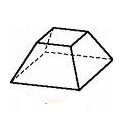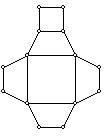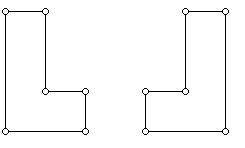
Homework I (Geometric Structures)
Prepared by:
Joseph Malkevitch
Department of Mathematics
York College (CUNY)
Jamaica, New York 11451
email:
malkevitch@york.cuny.edu
web page:
http://york.cuny.edu/~malk/
1. Draw at least 10 inequivalent nets for the solid obtained by truncating the tip of a square pyramid with a 2x2 square base and four equilateral triangles as the other faces. The truncation is made so the top square is 1x1. (Thus, the faces of the resulting "combinatorial cube" are two squares of different sizes and 4 congruent trapezoids.)

Here is a sample of one such net:

The crux of the issue here is what is meant by inequivalent. Consider the two shapes below:

It is not possible to rotate and/or translate the shape on the left onto the shape on the right. If this were possible we would say the two shapes are related by a rigid motion. However, there is a distance preserving transformation of one of the shapes onto the other, an isometry. This transformation is a reflection. If two shapes are related by an isometry they are called congruent. For nets it is customary to call two nets "different" if they are not congruent.
2. Can you find a complete list of inequivalent nets?